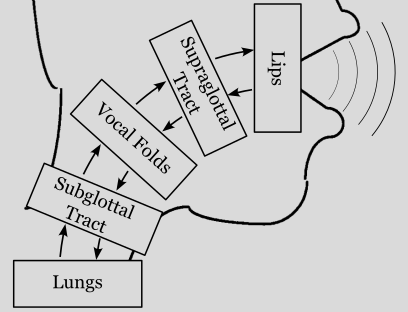Generating dysphonic voice samples with kinematic VF model#
Below are the videos and code snippets of the dysphonic voice syntheses presented at 2025 Voice Foundation Symposium [1]. (Some of the presented videos were combined versions of those below.)
Each code snippet illustrates how the syntheses were run to produce the signals
which are depicted in the video. For brevity, the Python code to produce the
video is omitted. In every example, three signals are retrieved after running
the lt.sim_kinematic function:
# Running the kinematic VF model simulation
pout, res = lt.sim_kinematic(...)
# Gather signals within vocal fold model
res_vf = res["vocalfolds"]
ag = res_vf.glottal_area
ug = res_vf.ug
Here we have:
ag- glottal area signal \(A_g\)ug- glottal flow signal \(U_g\)pout- acoustic signal \(P_{out}\)
The videos show the waveforms (left column) and spectra (right column) of these signals over 100-ms window. The bottom left is a coarse spectrogram to act as an indicator of playback position. If an example has a time-varying control parameter, it is shown beside the spectrogram at the bottom right.
Todo
Video production example will be added in the future.
1. Normal Voice (Baseline)#
import letalker as lt
from letalker import fs # 44.1 kS/s
T = 5 # sim duration
N = int(T * fs) # number of samples
# Simulate with symmetric kinematic vocal fold model
pout, res = lt.sim_kinematic(N, 100, "aa")
2. Breathy/pressed voice#
# Gradually widen the posterior gap from 0 to 0.3 cm
xim = 0.12 # vibration amplitude in cm
# vary Qa, abduction quotient (Titze 1984)
Qa = lt.StepGenerator(
[ 1, 2.5, 3.5],
[0.3, 0, 0.3, 0.2 / xim],
transition_type='linear',
transition_time_constant=0.2
)
# Simulate with kinematic vocal fold model
pout, res = lt.sim_kinematic(
N,
100,
"aa",
Qa=Qa,
xim=xim
aspiration_noise=True # Turn on noise injector
)
3. Voice Breaks#
fo = 100 # Hz
Tbreak = 0.02 # stoppage duration in seconds
# time-varying vocal fold vibration amplitude
# - attenuated momentarily for voice break effect
A = lt.Constant(
0.12, # cm
transition_times=[
0.45, 0.45 + Tbreak,
1.98, 1.98 + Tbreak,
3.02, 3.02 + Tbreak,
4.5, 4.5 + Tbreak,
],
transition_type="raised_cos",
transition_time_constant= Tbreak / 2,
transition_initial_on=True
)
# Simulate with symmetric kinematic vocal fold model
pout, res = lt.sim_kinematic(N, fo, "aa", xim=A)
4. Frequency Jumps#
# fo suddenly steps up or down
fo = lt.StepGenerator(
[0, 1.3, 3.9, T],
[100, 134, 156, 121],
transition_type="raised_cos",
transition_time_constant=0.01,
)
# Simulate with kinematic vocal fold model
pout, res = lt.sim_kinematic(
N, lt.SineGenerator(fo), "aa")
5. Flutter#
# Add ±1.5-Hz flutter to fo
fo_base = 100
FL = 25 # Klatt 1990 default
fo_max_dev = (FL / 50) * (fo_base / 100) * 3
fo = lt.FlutterGenerator(fo_max_dev, bias=fo_base)
# Reference VF motion signal
xi_ref = lt.SineGenerator(fo)
# Simulate with kinematic vocal fold model
pout, res = lt.sim_kinematic(N, xi_ref, "aa")
6. Vocal Tremor#
fo = 100
# Tremor parameters from Ramig & Shipp 1982
# ("incorrectly" applied to the VF motion)
mod_freq = 6.77 / fo # 6.77 Hz
am_extent = 40.6 / 100 # 40.6%
fm_extent = 2 ** (1.42 / 12) - 1 # 1.42 STs
xi_ref = lt.ModulatedSineGenerator(
fo, mod_freq, am_extent, fm_extent)
# Simulate with kinematic vocal fold model
pout, res = lt.sim_kinematic(N, xi_ref, "aa")
7. Modulation (locked, subharmonics)#
# Fixed parameters
fo = 100 # Hz
am_extent = 0.25
fm_extent = 0.1
# Step through 4 subharmonic periods: 1, 2, 3, 4
mod_freq = lt.StepGenerator(
levels = [0, 1/2, 1/3, 1/4],
transition_times = [1.25, 2.5, 3.75],
transition_type="raised_cos",
transition_time_constant=0.01,
)
# Define the modulated reference motion function
xi_ref = lt.ModulatedSineGenerator(
fo, mod_freq, am_extent, fm_extent)
# Simulate with kinematic vocal fold model
pout, res = lt.sim_kinematic(N, xi_ref, "aa")
8. Modulation (unlocked)#
# Fixed parameters (same as the subharmonic case)
fo = 100 # Hz
am_extent = 0.25
fm_extent = 0.1
# Pseudo-randomly vary between 0 and 0.5 at the rate
# no faster than 1 Hz, starting at 1 second mark
mod_freq = lt.FlutterGenerator(
fl=0.25, f=1.0, n=7, bias=0.25,
transition_times=1)
# Define the modulated reference motion function
xi_ref = lt.ModulatedSineGenerator(
fo, mod_freq, am_extent, fm_extent)
# Simulate with kinematic vocal fold model
pout, res = lt.sim_kinematic(N, xi_ref, "aa")
9. Biphonation (locked, subharmonics)#
# Keep one VF to vibrate at a fixed fo
fo0 = 100
# Define the progression of a pair of the fo’s
# locking the other VF’s fo at a rational ratio
fo = lt.StepGenerator(
[1.25, 2.5, 3.75],
[[fo0, fo0], [fo0, fo0*3/2],
[fo0, fo0*4/3], [fo0, fo0*5/4]],
transition_type="raised_cos",
transition_time_constant=0.01,
)
# Define the reference motion functions
xi_ref = lt.SineGenerator(fo)
# Simulate with kinematic vocal fold model
pout, res = lt.sim_kinematic(N, xi_ref, "aa")
10. Biphonation (unlocked)#
# Define two randomly wondering fo functions
# using the flutter mechanism (16 random sinusoids)
fo_mean = [100, 150]
fo_dev = [50, 100]
fo = lt.FlutterGenerator(
bias=fo_mean, fl=fo_dev, shape=2, f=0.2, n=16)
# Define the modulated reference motion function
xi_ref = lt.SineGenerator(fo)
# Simulate with kinematic vocal fold model
pout, res = lt.sim_kinematic(N, xi_ref, "aa")
11. Built-in vowels#
# Built-in vocal tract cross-sectional areas
from letalker.constants import vocaltract_areas
# 2-letter vowel names as keys to retrieve the areas
vowels = ["aa", "ii", "uu", "ae", "ih",
"eh", "ah", "aw", "uh", "oo"]
nvowels = len(names)
Tvowel = T / nvowels
# retrieve & stack areas of all vowels (10x44 array)
areas = np.stack(
[vocaltract_areas[vowel] for vowel in names], 0)
# Step through each vowel
transition_times = np.arange(1, nvowels) * Tvowel
vtarea_fun = lt.StepGenerator(transition_times,
areas, transition_time_constant=0.02)
# Simulate with kinematic vocal fold model
pout, res = lt.sim_kinematic(N, 100, vtarea_fun)
